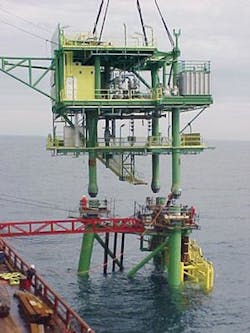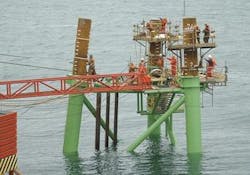Galata development easing Bulgaria's dependence on gas imports
Jeremy Beckman
Editor, Europe
April should be considered a landmark month for Bulgaria, as its first Black Sea development comes onstream. Gas from the Galata field will provide a domestic alternative to supplies from Russia. The project also marks the first offshore production venture for operator Melrose Resources.
Galata lies 16 mi southeast of the port of Varna, in 35 m of water. A group led by Texaco that had been targeting a Mesozoic oil play discovered the field in 1996. Texaco's partner, Enterprise Oil, assumed control of the surrounding block and identified numerous other prospective gas leads in this and adjacent acreage. The cumulative potential, in Enterprise's eyes, did not warrant further attention, leading to the interests changing hands once more in 1998.
The new owner, Petreco, was a Luxem-bourg-registered company that was in the process of being acquired by Melrose. The latter, based in Edinburgh, UK, had just been re-formed as an international E&P company, focusing on operations in the US and the eastern Mediterranean.
Although Bulgaria produces some oil from the onshore Tulenovo field – part of which extends into the Black Sea – all its gas is supplied by Gazprom through the Trans-Balkan gas pipeline network. State-owned distributor Bulgargaz owns and operates the long-distance branches through Bulgaria, including the transit gas loop to Greece and Turkey. The government has been looking to liberalize the distribution system, however, and new suppliers are currently entering the market. Some are working on local gasification schemes for the bigger cities, which also involve negotiating their own gas supplies, all of which will continue to be delivered through the Bulgargaz national distribution system.
null
Melrose saw an opportunity early on to develop a supply hub offshore, and at one point hoped for first gas in 2000. But pioneering is seldom painless. According to Chief Executive David Curry, "It took longer than we had expected to get the gas contract signed and then put in place the full project finance package. Our finance package is regarded as being the first true project finance debt in Bulgaria, and being the first to do something usually involves delay."
It took the company two years to clinch a production concession for Galata in May 2001. The 19-sq-km area is contained within the 1,690-sq-km offshore exploration block 91-111, operated and owned 100% by Petreco. Simultaneously, Petreco was awarded Kaliakra 99, a 2,600-sq-km offshore tract to the east and south, encompassing acreage explored the previous decade by BG and Enterprise.
In November of that year, a gas sales contract was signed under which Bulgargaz agreed to purchase 400 MMcm of gas from Galata for a minimum of two years (later extended to three), and a take-or-pay volume of 300 MMcm. The full contract quantity equates to around 12% of the country's current gas needs. Petreco also signed a gas transportation contract with Bulgargaz, allowing it to sell supplies directly to consumers in Bulgaria. At current gas prices, the value to Melrose is around $100/1,000 cu m.
During November 2002, Melrose finally secured the $55 m needed for the field's development and associated pipelines, although loan documentation was not completed until late March 2003. The International Finance Corp-oration in Washington and the Black Sea Trade & Development Bank, based in Salonika, Greece, provided the $34-million senior debt facility. The London-headquartered Eastern European Infrastructure Fund put up the $20.5 m mezzanine debt financing.
Platform re-think
Petreco's original ideas for the production scheme included relocation of ExxonMobil's redundant Camelot B platform from the southern North Sea. Curry explains that "around late-2000, early-2001, we became aware of a number of alternative tripod designs that looked much cheaper to build anew than the Camelot option. The latter's production facilities were also more complex and potentially expensive to operate in relation to our likely production stream."
During summer 2001, Petreco started to evaluate local yards on the Black Sea coast. Initial findings were not promising, but also not surprising, given the sporadic history of local offshore activity.
"With hindsight," Curry says, "we were perhaps influenced by the appearance of yards without appreciating the quality of workforce available. The Varna shipyard, however, came to our attention when it produced a stinger assembly for the Blue Stream pipeline project in the Black Sea. This demonstrated the yard's ability to fabricate our small platform. The yard is Italian-owned and the equipment available was adequate for this project. Worley in Abu Dhabi designed our platform, which cost $10 million to build. The jacket weight is 250 tonnes and the deck unit is 160 tonnes. The only offshore equipment items are a crane, a generator, and a small water knock-out package."
The platform does not require a helideck, as it can be reached by boat from Varna in 90 min. Produced gas will be sent directly to the shore for processing at a newly built terminal close to Varna. This plant will also control operations on the normally unmanned platform. Maintenance visits would normally be required monthly, but this installation will be monitored much more frequently for security reasons.
Float-out of the platform took place in October, following a five-month construction program. It was installed without incident by the Seaway Heavy Lifting heavy crane semi Alexander Udin. This was not the case with the 22-km, 14-in-diameter offshore pipelay operation. The barge sustained damage during a storm on December 24, and was forced back into port at Varna for repairs.
null
"Having lost our original pipelay barge due to financing delays, we had opted to use a 'DIY' barge set-up," Curry explains, "but this configuration is more appropriate for a summertime pipelay." Following the damage, work on the remaining 5.3 km offshore stretch did not resume until mid-February.
"Now that this operation is completed, we see no other reason why weather should affect production. There is no ice problem and the platform legs are of a standard build. Otherwise, there are no special technical difficulties, and the very soft bottom conditions in this area rendered trenching of the pipeline unnecessary," he said.
The 58-km, 12-in, onshore pipeline feeding Galata's gas into the national grid has also been completed. Securing environmental approval for the beach crossing took longer than expected, with the original plan having to be revised. "However, the local environmental authorities have since expressed complete satisfaction with re-instatement work performed at the beach site."
The two production wells for the initial development phase were both drilled and completed late last year, testing at rates of around 30 MMcf/d, and at wellhead pressure of 1,500 psi. The second well confirmed an extension of the gas reservoir in Galata's northern fault block. This has led to the field's proven reserves being upgraded from 49 to 65 bcf, while proven and probable reserves have been re-assessed at 90 bcf, compared with 80 bcf previously.
Later in field life, Petreco plans to drill the Bogdanov East accumulation in the southeastern area of the structure. If successful, the field extension could be tied back to the platform to sustain plateau production beyond 2006.
"There is one unused drilling slot on the platform," Curry says, "and there are two additional J-tubes that could be used to import gas from any other discoveries. Average daily output is expected to be over 40 MMcf/d, rising to 53 MMcf/d in winter. However, our production/ loading capacity is 120 MMcf/d, and each of the current development wells has deliverability of 60 MMcf/d, so we have quite a bit of flexibility."
An exploratory well drilled January last year on the Bogdanov North prospect 15 km north of Galata in block 91 III tested a possible extension of Galata's Maastrichtian-Palaeocene reservoirs. The well encountered a thicker than expected reservoir section, but no gas. The results provide evidence of good potential reservoirs in this part of the Black Sea, but hydrocarbon sourcing remains an issue.
Last August, Petreco hired a seismic vessel on a time-share basis with neighboring offshore acreage holders OMV and Vintage. On block III, this was used to acquire 500 km of infill 2D seismic. Subsequent interpretation led to the re-evaluation of several Galata look-alike structures.
"Of these, Varna West and East look most prospective in risk-reward terms," Curry said, "and we will drill one of them this summer. There are several prospects and leads in the north of block III, offshore from the Tulenovo field. We also believe there are some other fault blocks on the Galata structure [to the west] that may be separate compartments, and which would need to be tested in the future."
The reservoir rock is a cemented grainstone with very good permeability and porosity. High rates of flow can be achieved without the reservoir crumbling. Curry said the gas is 98% methane, with no associated "nasties" (laboratory quality, in effect) and the company has only had to make allowances for water production in due course.
"Our initial goal will be to establish a larger reserve base in order to increase the number of years at the steady plateau production rate under the existing contract," he said. "If we are able to make significant new discoveries – our analysis of the seismic suggests the Oligocene channel fill play could contain several structures with the potential for around 1 tcf in place – then obviously, the whole reserves/production balance would need to be adjusted."
Based on current proven and probable reserves, the Galata field has an estimated seven-year productive lifespan. Eventually, Petreco plans to convert the field for a dual gas storage/production role.
"This should take place when half the reserves have been produced, although we believe we could get away with a level of 65%," Curry said. "The rock is well cemented and very strong. During the summer, feed gas would be available from the domestic system, but in winter it could be produced back at high rates to meet demand spikes."
At this point, around 4.5 MW of compression would probably be added onshore, using gas-driven engines. The chosen level would be dependent on reservoir performance and remaining reserves. Optimus 2000 in Aberdeen has performed an outline design.
At its onshore headquarters in Varna, Petreco has recruited a mix of experienced gas production specialists and young engineering graduates for the development. It expects to sustain a 20-strong team through the production phase. Construction activities for this project provided short-term employment to around 500 Bulgarian nationals.
"We now know that we can rely on a very strong skills base in Bulgaria," Curry says, "and we would seek to do even more of the project work in Bulgaria for any further projects we may commit to."
So far, all the company's wells have been drilled by two jackups owned by the Ukrainian contractor Chermornaftagaz. "Both have performed very well, and we would hope that both will continue to be available."
On the Kaliakra 99 permit, Petreco has completed all initial work commitments. As the development phase of operations is completed, the focus will return to exploration. In the coming months, Petreco will present its program for a two-year extension on both the Kaliakra and block II concessions to the government. Previous operators identified a total of 19 prospects and leads across the Kaliakra permit, where water depths vary from 20-500 m. Enterprise acquired seismic over the former block II acreage but could not find a farm-in partner; British Gas drilled three dry holes in an area of very complex geology to the south of Galata. Also south of Galata, Comgeo made a small gas-condensate discovery, Samotino More R-1, which is thought to have tested a section of thin flysch sands encased in mudstone.
"We believe we will have to shoot new 3D seismic before any further drilling could be justified," Curry says. "This will cover not just the southern sector, but also offshore Tulenovo in the north, on what we believe is the oil migration path to Tulenovo from the deepwater kitchen area."


